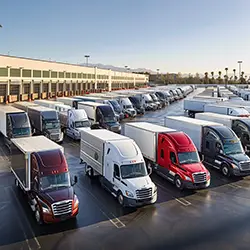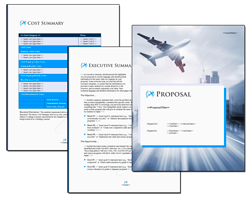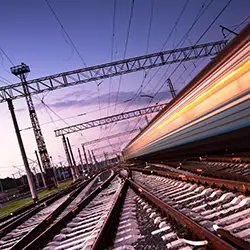
Your Guide on How to Write a Transportation Proposal: Tips & Tricks
How do you write a transportation proposal that drives success in the transportation industry? You will learn how to articulate your expertise, tailor your pitch to clients' needs, and present your services.
Key Takeaways
- A winning transportation proposal should start with an engaging and personalized introduction, outlining your expertise and setting a professional yet friendly tone for communication.
- Understanding and aligning with client needs is critical. This requires detailed research into client operations and the presentation of solutions that demonstrate alignment with their goals and enhance their value chain.
- The proposal should highlight your unique value propositions, detail services and support with transparent pricing strategies, and emphasize your company's credentials, achievements, and team expertise.
Types of Transportation Proposals
Here are some types of business proposals commonly written for transportation companies:
- Logistics and Supply Chain Management Proposals: Outlining services for managing the entire supply chain process, including warehousing, inventory management, and transportation.
- Fleet Management and Optimization Proposals: Presenting solutions for fleet maintenance, route optimization, and cost reduction strategies.
- Public Transportation Expansion Proposals: Proposing plans to expand or enhance public transportation services, including buses, trains, and subways.
- Corporate Transportation Services Proposals: Offering tailored transportation solutions for corporate clients, including employee shuttles and executive transportation.
- Freight Transportation and Shipping Proposals: Detailing domestic and international freight shipping services, including logistics planning and cargo handling.
- Sustainable and Green Transportation Proposals: Proposing eco-friendly transportation solutions, such as electric vehicle integration and carbon footprint reduction strategies.
- Technology and Innovation Proposals: Introducing advanced technologies for transportation management, such as GPS tracking systems, automated dispatching, and IoT applications.
- Emergency and Disaster Response Transportation Proposals: Offering specialized emergency transportation services, including natural disasters and crisis management.
- Customer Service and Experience Enhancement Proposals: Proposing improvements to customer service and passenger experience, including digital ticketing, real-time tracking, and customer feedback systems.
- Government Contract Transportation Proposals: Seeking government contracts to provide transportation services, including school bus services, military logistics, and public sector transportation needs.
Structure of a Transportation Proposal

The basic proposal structure is the same, whether your business is shipping services, import/export services, logistics management, personal transportation services, or even asking for funding to create or grow a transportation business.
Here's the order your proposal sections should follow: 1) introduce yourself, 2) summarize the prospective client's needs, 3) describe your products, services, and costs, and finally, 4) provide information about your organization, your credentials, and your capabilities.
Creating Your Opening Move
An engaging initial step in your transportation proposal can be likened to a solid handshake; it paves the way for future discussions and initiates the trust-building process. With a carefully written cover letter, you create a roadmap drawing the client in.
Introducing your business at the onset can grab the client's interest, similar to how most companies use a headline to draw a reader's curiosity. Using a transportation proposal template can further streamline this process, ensuring all essential elements are covered immediately.
Personalizing Your Introduction
Imagine receiving a letter that speaks directly to you, addressing challenges you face daily as a specific client. That's the power of personalizing your introduction. Using the recipient's name and mentioning their business hurdles can foster an instant rapport that strikes a personal chord.
Recalling prior meetings or interactions adds layers of familiarity and trust, turning a generic cover letter into a tailored communique that speaks volumes about your commitment to the client's success.
Outlining Your Expertise

Your proposal must vividly demonstrate your expertise in the transportation business. The experience you convey shapes the reader's expectations and establishes your authority in the industry.
To showcase your expertise, consider:
- Mentioning relevant past projects
- Leveraging sector-specific skills
- Demonstrating your ability to specialize in solutions that align with the client's goals
These strategies will help you establish credibility and make a strong impression on potential clients.
Quotes from satisfied clients or assessing officials serve as testimonials to your successful track record and illustrate your unique approach to transportation challenges.
Setting the Tone for Communication

The proposal's introduction sets the tone throughout your discourse with the client. It must resonate with professionalism with a friendly undertone, setting a collaborative tone for future interactions.
A welcoming yet earnest voice in your introduction invites the client into a dialogue, encouraging them to engage genuinely with the proposal and, by extension, your company.
Understanding Client Needs
Looking into the core of your prospective client's business and objectives extends beyond mere data collection; it involves comprehending the story behind their needs. Tailoring your proposal to its unique context is essential for a successful engagement and requires a mix of research, inquiry, and insight.
By asking targeted questions and examining the specifics of their supply chain and objectives, you align your services with their needs and demonstrate a willingness to go the extra mile.
Gathering Important Details
Each detail contributes to the overall image within the mosaic of client requirements. Understanding these elements, from the types of goods transported to preferred modes and special handling requirements, is crucial for creating a solution that fits. Employ a combination of interviews, site visits, and data analysis to ensure you comprehensively understand the logistical needs.
A well-structured introduction to these details in your proposal sets the stage for presenting tailored opportunities for service improvements.
Structuring the Needs Summary

Organizing client needs is akin to charting a map for a complex journey. Customer discussions and interviews bring the client's perspective to the forefront, ensuring that the structured summary of their needs reflects their voice and concerns. Including qualitative and quantitative data, such as client satisfaction and service comparisons, provides a holistic view of what the client values and expects from your services.
A diagram then serves as a tool to visualize the client's supply chain and pinpoint where value is created and where your services can enhance it.
Demonstrating Alignment with Client Goals
Your proposal should mirror the client's current and future goals. It's about showing how your transportation services are a fit and a choice that aligns precisely with their short-term and long-term goals. Demonstrating coordination across various entities to enhance capacity and efficiency is critical to a proposal that meets and anticipates the client's operational requirements.
A detailed plan that reflects thoughtful resource allocation and alternative actions shows that you've considered the client's long-term strategy, positioning your solution as superior and thorough.
Presenting Your Transportation Solutions
Imagine a solution that not only answers today's challenges but also paves the way for tomorrow's successes. Presenting your transportation solutions is about highlighting the tangible benefits they bring, such as enhanced safety, time savings, and cost reductions. It's about demonstrating the added value that comes from choosing your services.
A benefit-cost analysis can be a powerful instrument for demonstrating the financial worth of transportation services. It guarantees that the client perceives the advantages relative to the projected expenses.
Detailing Services and Support

Your proposal should depict the spectrum of services and support you provide. From freight management to scheduling and storage solutions, your proposal should reflect a spectrum of services that cater to your clients' varied needs.
Tailoring these services to the client's communication preferences and showcasing multiple pricing options can significantly enhance the attractiveness of your proposal, ensuring you cater to different client preferences and attract more clients.
Transparent Pricing Strategies
Price transparency forms the bedrock of trust in any commercial relationship. Clear cost summaries that detail the services provided help clients understand the value they are receiving beyond the numbers on a price list. A well-organized pricing table in your proposal can make the financial details clear and understandable, directly address the client's requests, and demonstrate an understanding of the project's costs and deliverables.
Proposal Kit's line item database system, which generates your financial page, adds another layer of transparency, ensuring that rates and job costs are communicated clearly and effectively.
Highlighting Unique Value Propositions
What sets your company apart as the best solution amidst many competitors? Your unique value propositions, such as specialized skills or service offerings, set you apart. Case studies that reflect the breadth and depth of your capabilities establish credibility and resonate with the prospective project, demonstrating the diverse applications of your expertise.
Highlighting specialized transport services in the transportation business, such as different vehicle types or large-scale event transportation logistics, showcases your operational expertise and directly ties it to desirable project outcomes like improved comfort and reduced noise pollution.
Creating a Winning Proposal Template

Just as the blueprint underpins any remarkable structure, a winning transportation proposal is based on the same. Proposal Kit templates and software are the tools that provide the structure and professionalism to ensure your document stands out. These templates offer a consistent, polished format that includes all the essential elements of a proposal, streamlining the creation process and guaranteeing that nothing important is overlooked.
Using Customizable Templates
Adaptable templates act as the flexible framework bolstering your proposal's distinctive structure. By adapting pre-built layouts and pre-written sections, you can articulate your services with clarity and precision.
Transportation proposal templates with pre-written sections tailored to the client's needs help ensure your document accurately represents your offerings. Proposal Kit's offerings, including the Proposal Pack Wizard software, bring hundreds of ready-made layouts for diverse proposal needs right to your fingertips, available in a convenient PDF file format.
Incorporating Professionalism and Consistency
Proposal Kit ensures this consistency across proposals, providing a systematized format that can be adapted for any transportation scenario. By incorporating customizable elements such as logos and brand colors into your Proposal Kit documents, you create a seamless brand experience across all proposal documents, reinforcing your company's professional image.
Adapting to Different Transport Scenarios
Your proposal must be flexible enough to address the distinct challenges of various transport situations. Proposal Kit provides sector-specific templates and layouts to meet the diverse needs of the shipping and logistics industry.
Using the Proposal Kit ensures that your proposal remains tailored to the specific requirements of each scenario regardless of the business type - be it shipping services, import/export services, or logistics management.
Here are some related samples included in every downloadable Proposal Pack
The AI Writer generates a first draft of these templates - customized to your company, client, and project - in just minutes, giving you a head start on editing. Get any Proposal Pack or Proposal Kit Professional, and all of these samples, and the AI Writer are included.
- Transportation Shipping Services Sample Proposal
- Import Export Services Sample Proposal
- Manufacturing and Distribution Sample Proposal
- Aerospace / Aviation Services Sample Proposal
- Request for Proposal (RFP) Sample
- Drone Delivery in Disaster Area Sample Proposal
- Transportation Request for Proposal (RFP) Sample
- Limousine Transportation Services Sample Proposal
Here are some related downloadable templates
The AI Writer generates a first draft of these templates - customized to your company, client, and project - in just minutes, giving you a head start on editing. Get any Proposal Pack or Proposal Kit Professional, and all of these templates and the AI Writer are included.
- Bus Transportation Services Proposal (Short)
- Fleet Management Proposal
- Limousine Transportation Services Proposal
- Medical Equipment Supply and Transportation Proposal
- Medical Transportation Services Proposal
- Medical Waste Transportation Proposal
- Moving Transportation Services Proposal
- Oil Tanker Business Proposal
- Sanitary Transportation Food Safety Proposal
- Transportation (Supplying Drivers) RFP Response
- Transportation Shipping Services Proposal
- Transportation of Hazardous Waste Proposal
- Valet Parking Services Proposal
- Vehicle Fleet Supply for Event Proposal
Bolstering Your Business Credentials
A key component of your business proposal is your qualifications, underscoring your capacity and proficiency. Including achievements, certifications, and your team's qualifications validates your track record and amplifies your credibility. It's about painting a picture for your client of a business that meets industry standards and delivers exceptional services.
Showcasing Company Achievements
Sharing measurable results, such as reduced shipping times or cost savings, provides concrete evidence of your capability to innovate and achieve. Testimonials and case studies bring human voices into the narrative, emphasizing the satisfaction and trust of those who have experienced your services.
A curated portfolio within your proposal showcases your successes and demonstrates your ability to meet and exceed specific client expectations while respecting the confidentiality of previous clients.
Certifications and Insurance
Including certifications and insurance in your business proposal is an endorsement that assures clients of your dedication to industry norms. Detailing these credentials showcases your commitment to quality and risk management, which are critical considerations for any potential client.
Certificates of Insurance (COIs) are the proof of your protective measures against potential risks, providing critical information like: Policyholder's name, Policy dates, Type of Coverage, and Policy limits.
Including endorsements for additional insured parties further extends the coverage and illustrates your thoroughness in safeguarding all stakeholders involved in your operations.
Introducing the Team

Introducing the credentials of key team members in your proposal is like showcasing the captains and navigators who possess the expertise and experience necessary for the voyage ahead. Each member's background adds unique value, reflecting the company's field authority and commitment to delivering quality service.
Closing with Clarity
As you make your closing statements in your transportation proposal, the final act should instill in the client a comprehension of the value proposition and a sense of immediacy to act. Summarizing the content and providing a direct call to action ensures that the reader is guided toward the desired outcome.
Summarizing Key Points
The proposal's closure serves as an encore that reiterates the primary themes. It's where you restate the benefits and value propositions without overwhelming the reader with details, ensuring that the compelling message presented throughout the proposal is reinforced.
Outlining Next Steps
A well-defined path ahead is crucial in transitioning from proposal to partnership. Outlining the next steps in your proposal shows initiative and establishes a timeline for action, which is essential for maintaining momentum.
Encourage the client to schedule a discussion to address any questions, review the proposal in detail, and specify how and when they should respond to keep the project moving forward.
Offering Additional Support
Your proposal's closing words should reverberate the service commitment that permeates your enterprise. Offering additional support and including contact details ensures the client knows your team is ready and willing to assist with any inquiries, reinforcing the message that you are a partner invested in their success.
 Proposal Kit Professional provides the most content, including legal contracts and a free design theme pack. Plus, advanced software features include custom branding and customizable quoting databases.
Proposal Kit Professional provides the most content, including legal contracts and a free design theme pack. Plus, advanced software features include custom branding and customizable quoting databases. Proposal Pack for Any Business covers this type of proposal and includes samples. There are also some commonly used specialty design themes available:
Proposal Pack for Any Business covers this type of proposal and includes samples. There are also some commonly used specialty design themes available:Photo Design Proposal Packs
 Proposal Pack Aerospace #5
Proposal Pack Aerospace #5 Proposal Pack Business #22
Proposal Pack Business #22 Proposal Pack Global #4
Proposal Pack Global #4 Proposal Pack In Motion #7
Proposal Pack In Motion #7 Proposal Pack In Motion #8
Proposal Pack In Motion #8 Proposal Pack Medical #8
Proposal Pack Medical #8 Proposal Pack Transportation #10
Proposal Pack Transportation #10 Proposal Pack Transportation #11
Proposal Pack Transportation #11 Proposal Pack Transportation #5
Proposal Pack Transportation #5 Proposal Pack Transportation #6
Proposal Pack Transportation #6 Proposal Pack Transportation #7
Proposal Pack Transportation #7 Proposal Pack Transportation #8
Proposal Pack Transportation #8 Proposal Pack Transportation #9
Proposal Pack Transportation #9
Line Art Design Proposal Packs
 Proposal Pack Aerospace #1
Proposal Pack Aerospace #1 Proposal Pack Aerospace #2
Proposal Pack Aerospace #2 Proposal Pack Global #1
Proposal Pack Global #1 Proposal Pack Global #2
Proposal Pack Global #2 Proposal Pack Global #3
Proposal Pack Global #3 Proposal Pack In Motion #1
Proposal Pack In Motion #1 Proposal Pack In Motion #2
Proposal Pack In Motion #2 Proposal Pack In Motion #3
Proposal Pack In Motion #3 Proposal Pack In Motion #4
Proposal Pack In Motion #4 Proposal Pack In Motion #5
Proposal Pack In Motion #5 Proposal Pack In Motion #6
Proposal Pack In Motion #6 Proposal Pack Transportation #1
Proposal Pack Transportation #1 Proposal Pack Transportation #2
Proposal Pack Transportation #2 Proposal Pack Transportation #3
Proposal Pack Transportation #3 Proposal Pack Transportation #4
Proposal Pack Transportation #4
Summary
In summary of the intricacies of creating a transportation proposal, we reflect on the importance of a tailored approach, the clarity of presenting solutions, and the strength of a well-structured proposal. We have navigated you through the steps to constructing a document that meets the client's needs and showcases your company's unique value. Let the insights gleaned here inspire you to create proposals that win clients and build lasting partnerships.
Frequently Asked Questions
What are the critical elements of a transportation proposal?
The critical elements of a transportation proposal encompass a personalized introduction, an understanding of client needs, detailed service descriptions, transparent pricing, unique value propositions, a professional template, solid business credentials, and a conclusive call to action. These elements are vital for a comprehensive and effective transportation proposal.
How can I ensure my proposal aligns with the client's goals?
To ensure your proposal aligns with the client's goals, conduct thorough research into their business objectives, customize your services to their specific needs, and demonstrate how your solutions will help achieve their short-term and long-term goals. This will showcase your understanding of their requirements and increase the probability of a successful proposal.
What is the importance of including pricing in my proposal?
Including a pricing table in your proposal is essential. It provides transparency and helps the client understand the financial details of your services, making the value you offer clear and understandable. It builds trust and improves decision-making.
How can Proposal Kit templates help me create a winning proposal?
Proposal Kit templates can help you create a winning proposal by providing a structured format, ensuring consistency and professionalism, and allowing customization to meet unique requirements. This will enhance your chances of putting together a strong and compelling proposal.
What should I include in the closing of my proposal?
In the closing of your proposal, summarize the key benefits, outline the following steps, and offer additional support and contact details for further inquiries. This will leave a strong and positive impression on the client.



 Cart
Cart
 Are you just looking for a template, sample, or software for your transportation proposals? Click these links to skip down the page and get right to it.
Are you just looking for a template, sample, or software for your transportation proposals? Click these links to skip down the page and get right to it.

 Facebook
Facebook YouTube
YouTube Bluesky
Bluesky Search Site
Search Site